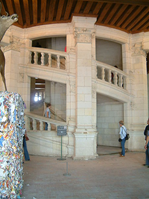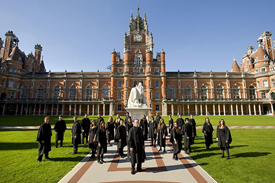Leonardo da Vinci and his unwitting influence on Egham
2019 marked the 500th anniversary of the death of Leonardo da Vinci – but how is he connected to Egham?
Although based in Italy working for the Sforza and Medici families amongst others, Leonardo also collaborated on projects for the kings of France. In 1516, when he was in his sixties, he moved to France and became painter, architect and engineer to Francois I, who allowed him to live in the Château du Clos Lucé in the Loire valley. In his studio at the château he worked on plans for many uncompleted protects, including the design for a double helix staircase where people can go up and own without passing each other.
Leonardo died in 1519 and was buried at Clos Lucé – the year that work began on the nearby Château de Chambord, a hunting palace for Francois I. Leonardo’s part in planning the château is uncertain but its website[i] states “His influence on conception of the project and construction of the château may be identified by comparing the architectural plans adopted (centred keep, the double-helix staircase, double-pit latrine with air duct, waterproofing system for the terraces…) with the sketches in Leonardo’s notebooks.”
The design also reflects Leonardo’s plans for a château at Romorantin for the King’s mother.

The design and architecture of the château inspired William Henry Crossland for his design of the Founder’s building at Royal Holloway which features very similar towers and layout but was built using red bricks.


So we have Egham’s very own link to Leonardo da Vinci!
[i] Chateau du Chambord (2019) Leonardo Da Vinci, Chambord Architect? https://www.chambord.org/500-years/post/leonardo-da-vinci-chambord-architect/ [Accessed 29 August 2019]


